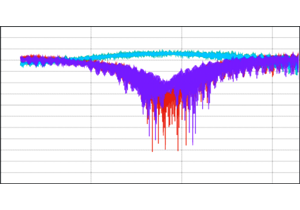Properties of low-temperature GaAs obtained by LPE method for terahertz devices
DOI:
https://doi.org/10.3103/S0735272724080041Keywords:
gallium arsenide, rare-earth element, liquid phase epitaxy, LPE, resistivity, terahertz radiationAbstract
The paper presents the results of studying the peculiarities of the high-resistivity low-temperature gallium arsenide formed by the liquid-phase epitaxy (LPE) method under the influence of complex doping of gallium melts with the rare earth element dysprosium and aluminum. The electrophysical properties of the epitaxial layers were studied using the Van der Pauw method. The measurements were carried out in the frequency range of 80–145 GHz using a quasi-optical setup based on a VNA vector analyzer with a pair of frequency expanders operating in the VDI WR-3.4 range. This made it possible to measure the full complex scattering parameters of the two-pole. It is shown that at concentrations of dysprosium (3.7–5.0)×10–2 at.% and aluminum (2.1–3.8)×10–4 at.%, high-resistivity layers of GaAs, Al0.05Ga0.95As, Al0.1Ga0.9As with resistivity values of (3–7)×105 W·cm are formed. The comparison of the studied transmission-reflection spectra of terahertz signals in the specified frequency range through the epitaxial structure of GaAs–SiGaAs (substrate) and the semi-insulating gallium arsenide substrate showed that they were identical. Low-temperature LPE, which is based on the simultaneous doping of gallium melts with aluminum and dysprosium, can be used to form high-resistance layers of gallium arsenide and its solid solutions suitable for use in devices of the terahertz range.
References
- C. M. Collier, T. J. Stirling, I. R. Hristovski, J. D. A. Krupa, J. F. Holzman, “Photoconductive terahertz generation from textured semiconductor materials,” Sci. Reports, vol. 6, no. 1, p. 23185, 2016, doi: https://doi.org/10.1038/srep23185.
- R. J. B. Dietz, B. Globisch, H. Roehle, D. Stanze, T. Göbel, M. Schell, “Influence and adjustment of carrier lifetimes in InGaAs/InAlAs photoconductive pulsed terahertz detectors: 6 THz bandwidth and 90dB dynamic range,” Opt. Express, vol. 22, no. 16, p. 19411, 2014, doi: https://doi.org/10.1364/OE.22.019411.
- R. J. B. Dietz et al., “Low temperature grown photoconductive antennas for pulsed 1060 nm excitation: Influence of excess energy on the electron relaxation,” J. Infrared, Millimeter, Terahertz Waves, vol. 36, no. 1, pp. 60–71, 2015, doi: https://doi.org/10.1007/s10762-014-0119-3.
- S.-G. Park, K. H. Jin, M. Yi, J. C. Ye, J. Ahn, K.-H. Jeong, “Enhancement of terahertz pulse emission by optical nanoantenna,” ACS Nano, vol. 6, no. 3, pp. 2026–2031, 2012, doi: https://doi.org/10.1021/nn204542x.
- S. I. Krukovskyi, V. Arikov, A. O. Voronko, V. S. Antonyuk, “Features of low-temperature GaAs formation for epitaxy device structures,” J. Nano- Electron. Phys., vol. 14, no. 2, pp. 02016-1-02016–5, 2022, doi: https://doi.org/10.21272/jnep.14(2).02016.
- J. S. C. Chang, D. W. Kisker, D. A. Stevenson, “Oxygen behavior in liquid phase epitaxial GaAs,” Solid-State Electron., vol. 28, no. 5, pp. 479–484, 1985, doi: https://doi.org/10.1016/0038-1101(85)90111-X.
- S. I. Krukovsky, A. Fedorchuk, “Mechanism of cleaning epitaxial layers GaAs, InGaAsP under the influence of complex doping in melts by rare-earth elements and aluminium in technology LPE,” Phys. Chem. Solid State, vol. 7, pp. 751–762, 2006.
- D. Zayachuk, N. Strukhlyak, S. Krukovsky, E. Goovaerts, Y. Polyhach, “GaAs thin films grown by LPE under influence of Yb impurity,” in Proc. 12th Gallium Arsenide and Other Compound Semiconductors Application Symposium, 2004, pp. 11–12, doi: https://doi.org/10.6092/unibo/amsacta/1089.
- M. Wan, Y. Yashchyshyn, X. Lin, K. Godziszewski, D.-W. Sun, J. T. Sheridan, “Characterization of silicon in the terahertz,” in Terahertz, RF, Millimeter, and Submillimeter-Wave Technology and Applications XIII, 2020, p. 83, doi: https://doi.org/10.1117/12.2547339.


